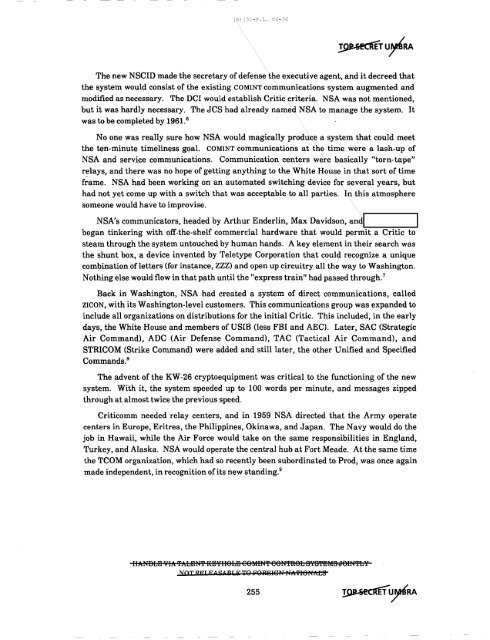American Cryptology during the Cold War - The Black Vault
American Cryptology during the Cold War - The Black Vault
American Cryptology during the Cold War - The Black Vault
You also want an ePaper? Increase the reach of your titles
YUMPU automatically turns print PDFs into web optimized ePapers that Google loves.
Ib) (3) -P.L. 86-36<br />
<strong>The</strong> new NSCID made <strong>the</strong> secretary of defense <strong>the</strong> executive agent, and it decreed that<br />
<strong>the</strong> system would consist of <strong>the</strong> existing COMINT communications system augmented and<br />
modified as necessary. <strong>The</strong> DCI would establish Critic.criteria. NSA was not mentioned,<br />
but it was hardly necessary. <strong>The</strong> JCS had already named NSA to manage <strong>the</strong> system. It<br />
was to be completed by 1961. 6<br />
No one was really sure how NSA would magically produce a system that could meet<br />
<strong>the</strong> ten-minute timeliness goal. COMINT communications at <strong>the</strong> time were a lash-up of<br />
NSA and service communications. Communication centers wete basically «torn-tape"<br />
r~lays, and <strong>the</strong>re was no hope of getting anything to <strong>the</strong> White House in that sort of time<br />
frame. NSA had been working on an automated switching device lOf several years, but<br />
had not yet come up with a switch that was acceptable to all parties. In this atmosphere<br />
someone would have to improvise.<br />
NSA's communicators, headed by Arthur Enderlin, Max Davidson, andl<br />
began tinkering with off-<strong>the</strong>-shelf commercial hardware that would permit a Critic to<br />
steam through <strong>the</strong> system untouched by human hands. A key element in <strong>the</strong>ir search was<br />
<strong>the</strong> shunt box, a device invented by Teletype Corporation that could recognize a unique<br />
combination ofletters (for instance, ZZZ) and open up circuitry all <strong>the</strong> way to Washington.<br />
Nothing else would flow in that path until <strong>the</strong> «express train" had passed through. 7<br />
Back in Washington, NSA had created a system of direct communications, called<br />
ZICON, with its Washington-level customers. This communications group was expanded to<br />
include all organizations on distributions for <strong>the</strong> initial Critic. This included, in <strong>the</strong> early<br />
days, <strong>the</strong> White House and members of USIB (less FBI and AEC). Later, SAC (Strategic<br />
Air Command), ADC (Air Defense Command), TAC (Tactical Air Command), and<br />
STRICOM (Strike Command) were added and still later, <strong>the</strong> o<strong>the</strong>r Unified and Specified<br />
Commands. 8<br />
<strong>The</strong> advent of <strong>the</strong> KW-26 cryptoequipment was critical to <strong>the</strong> functioning of <strong>the</strong> new<br />
system. With it, <strong>the</strong> system speeded up to 100 words per minute, and messages zipped<br />
through at almost twice <strong>the</strong> previous speed.<br />
Criticomm needed relay centers, and in 1959 NSA directed that <strong>the</strong> Army operate<br />
centers in Europe, Eritrea, <strong>the</strong> Philippines, Okinawa, and Japan. <strong>The</strong> Navy would do <strong>the</strong><br />
job in Hawaii, while <strong>the</strong> Air Force would take on <strong>the</strong> same responsibilities in England,<br />
Turkey, and Alaska. NSA would operate <strong>the</strong> central hub at Fort Meade. At <strong>the</strong> same time<br />
<strong>the</strong> TCOM organization, which had so recently been subordinated to Prod, was once again<br />
made independent, in recognition ofits new standing. 9<br />
I<br />
IIAN'BLF:l VIA 'fALF:lN''f l(F:lYIISLF:l eSMIN'f eSN''fRSL SYS'fF:lMS dSIN'fLY<br />
NOT RET FASARbi: TQ ¥QRSI6Pf Pfz't'ff6ff*LS<br />
255
















